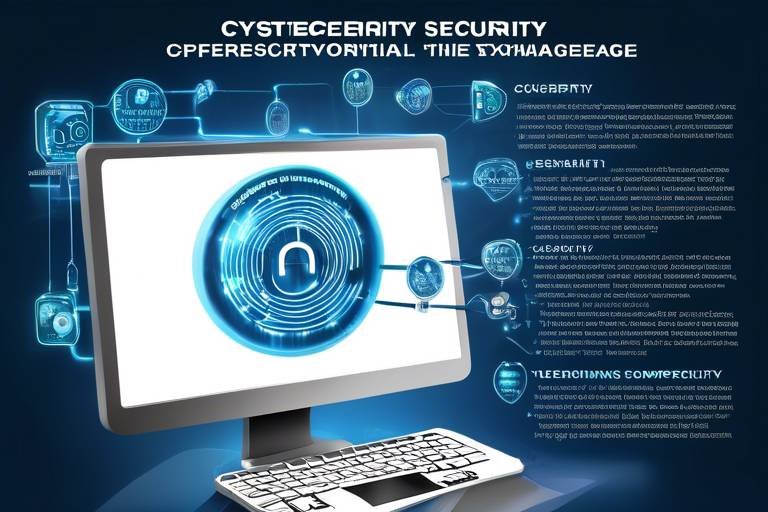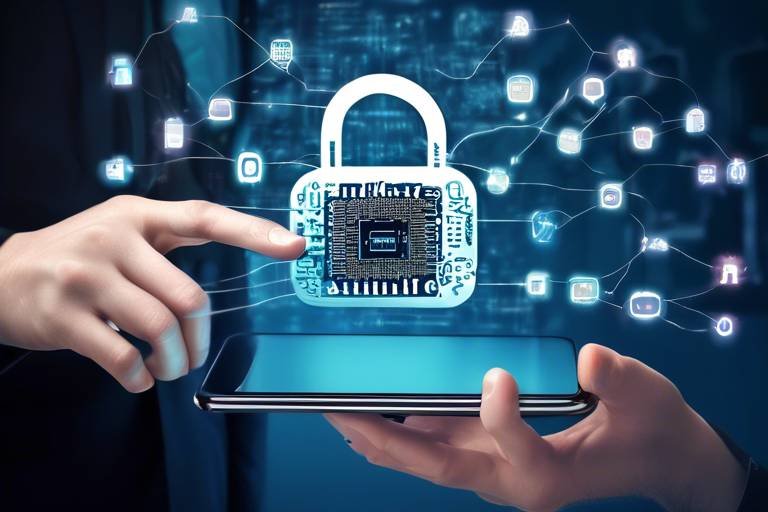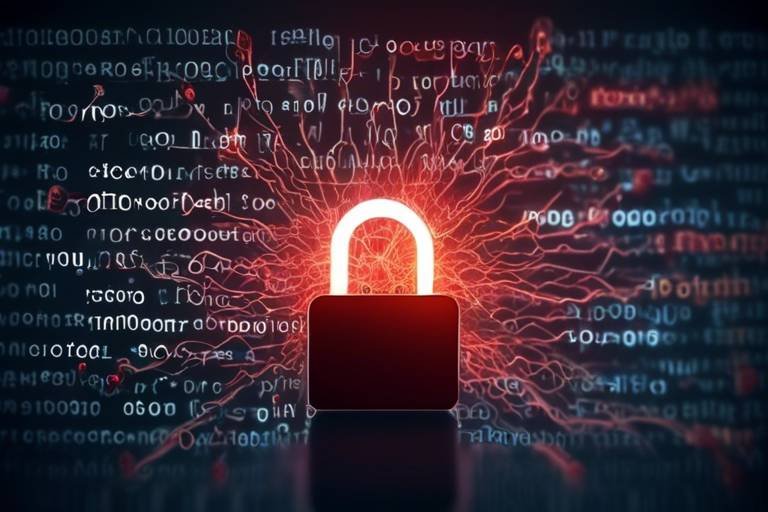Cybersecurity vs Computer Security - Understanding the Difference
In today's digital landscape, the terms cybersecurity and computer security are often used interchangeably, but they represent distinct concepts that play crucial roles in protecting our digital environments. Imagine navigating a bustling city; cybersecurity is like the traffic system that keeps everything moving smoothly while preventing accidents, whereas computer security is akin to the locks on your doors and windows, ensuring that your personal space remains safe from intruders. Understanding the differences between these two fields is essential for anyone looking to safeguard their information and systems effectively.
Cybersecurity primarily focuses on protecting internet-connected systems, encompassing everything from hardware and software to data. With the rise of the internet and cloud computing, the scope of cybersecurity has expanded significantly. It deals with safeguarding networks from unauthorized access and attacks that can lead to data breaches, identity theft, and other cybercrimes. In contrast, computer security zeroes in on the protection of individual computer systems and their components. It emphasizes securing physical devices and software applications from theft, damage, and unauthorized access.
To illustrate this further, let's break down the key components of each field:
| Aspect | Cybersecurity | Computer Security |
|---|---|---|
| Focus | Networks and data | Individual systems and components |
| Threats | Cyber attacks, malware | Physical theft, software vulnerabilities |
| Protection Measures | Firewalls, encryption | Antivirus software, physical locks |
While these two domains serve different purposes, they are interconnected and often overlap. For instance, a robust cybersecurity strategy will include elements of computer security, such as ensuring that individual devices are secure before they connect to the network. Similarly, computer security measures can enhance overall cybersecurity by protecting endpoints from threats. This synergy is vital, especially in an era where cyber threats are constantly evolving, and the lines between personal and professional data are increasingly blurred.
In conclusion, while cybersecurity and computer security may seem like two sides of the same coin, they each bring unique perspectives and strategies to the table. By understanding their differences and how they complement each other, individuals and organizations can better prepare themselves to face the myriad of threats lurking in the digital world.
- What is the main difference between cybersecurity and computer security? Cybersecurity focuses on protecting internet-connected systems and networks, while computer security emphasizes securing individual computers and their components.
- Why is cybersecurity important? With the increasing number of cyber threats, cybersecurity is essential to protect sensitive data, maintain privacy, and ensure the integrity of systems.
- Can computer security measures improve cybersecurity? Yes, implementing strong computer security practices can enhance overall cybersecurity by safeguarding devices before they connect to a network.

Defining Cybersecurity
Cybersecurity is a term that has become increasingly important in our digital age. It encompasses the protection of internet-connected systems, which include not just hardware and software but also the vast amounts of data that flow through them. Think of it as a digital fortress, built to defend against a myriad of cyber threats that can compromise the integrity and confidentiality of our information. With the rise of the internet, the boundaries of our personal and professional lives have blurred, making cybersecurity not just a technical issue but a fundamental aspect of our daily existence.
The primary goal of cybersecurity is to safeguard networks and data from unauthorized access and attacks. Imagine your home: you lock your doors, install an alarm system, and keep an eye on who comes and goes. Similarly, cybersecurity employs various strategies and tools to protect digital assets. This includes everything from firewalls and antivirus software to advanced encryption techniques that secure sensitive data.
Moreover, cybersecurity is not just about technology; it's also about people and processes. Organizations often implement cybersecurity policies that define how employees should handle sensitive information and respond to potential threats. Training and awareness are crucial, as human error can often be the weakest link in the security chain.
To better understand cybersecurity, it can be helpful to break it down into several key components:
- Network Security: Protecting the integrity and usability of networks.
- Application Security: Safeguarding software applications from vulnerabilities.
- Information Security: Ensuring the confidentiality and integrity of data.
- Operational Security: Protecting the processes and policies that govern data handling.
Each of these components plays a vital role in creating a comprehensive cybersecurity strategy. For instance, network security focuses on defending against unauthorized access and various cyber threats targeting network infrastructures. On the other hand, application security is all about ensuring that the software we use is resilient against attacks.
In conclusion, understanding cybersecurity is crucial in today's interconnected world. As we become more reliant on technology, the threats we face evolve, making it imperative to stay informed and prepared. Just like you'd never leave your front door wide open, we must also take proactive measures to secure our digital lives. The battle against cyber threats is ongoing, but with the right knowledge and tools, we can fortify our defenses and protect our valuable information.

Understanding Computer Security
When we talk about computer security, we're diving into a realm that focuses specifically on protecting individual computer systems and their components from a variety of threats. Think of it as locking your front door to keep intruders out, but in the digital world. It encompasses several layers of protection, from the hardware itself to the software applications running on it. In essence, computer security is about ensuring the integrity, confidentiality, and availability of your data and systems.
At its core, computer security is comprised of three key components: hardware security, software security, and data security. Each of these components plays a vital role in the overall security landscape. Let’s break them down:
- Hardware Security: This involves protecting the physical components of a computer system, such as the CPU, hard drives, and other peripherals. Physical theft or damage can lead to severe data breaches, making hardware security a top priority.
- Software Security: This focuses on safeguarding the software applications and operating systems from vulnerabilities. Flaws in software can be exploited by malicious actors, which is why regular updates and patches are crucial.
- Data Security: This aspect ensures that sensitive information is protected from unauthorized access and breaches. It includes encryption methods, access controls, and backup strategies to maintain data integrity.
Moreover, computer security is not just about having the right tools; it's also about developing a security mindset. Users must be educated about potential threats and best practices for maintaining security. For instance, using strong passwords, enabling two-factor authentication, and being cautious about suspicious emails can significantly reduce the risk of a security breach.
Another vital aspect of computer security is the implementation of security policies. These are guidelines and procedures that dictate how to protect computer systems and data. They often include instructions on how to handle sensitive information, respond to security incidents, and maintain compliance with legal and regulatory requirements. A well-defined security policy can serve as a roadmap for organizations, ensuring that everyone is on the same page when it comes to security practices.
In today's interconnected world, the lines between computer security and cybersecurity often blur. While computer security focuses on individual systems, cybersecurity takes a broader approach, encompassing the protection of networks and data across the internet. However, both are essential for creating a robust security posture. Just as a house needs strong locks and alarms, organizations need both computer and cybersecurity measures to fend off increasingly sophisticated threats.
In conclusion, understanding computer security is crucial for anyone who uses technology, whether at home or in the workplace. By recognizing the importance of hardware, software, and data security, and implementing effective security policies and practices, we can create a safer digital environment for ourselves and our organizations.

Key Components of Cybersecurity
When we talk about cybersecurity, we're diving into a vast ocean of protective measures designed to shield our digital lives from a myriad of threats. To navigate this complex landscape, it's crucial to understand the key components that make up this essential field. Cybersecurity is not a one-size-fits-all solution; rather, it comprises various elements that work together like gears in a well-oiled machine. Each component plays a pivotal role in ensuring the safety and integrity of our information and systems.
At the heart of cybersecurity, we find network security, which is all about protecting the integrity and usability of networks. Imagine your network as a bustling city, where data packets are like cars navigating through traffic. Just as a city needs traffic lights and roadblocks to prevent accidents, network security implements measures such as firewalls and intrusion detection systems to defend against unauthorized access and cyber threats. Without these safeguards, our data could easily fall into the wrong hands, leading to catastrophic consequences.
Then we have application security. Think of applications as the storefronts in our digital city. They need to be secure to prevent thieves from breaking in and stealing sensitive information. Application security focuses on protecting software applications from vulnerabilities and attacks. This involves practices like code reviews, penetration testing, and incorporating security measures throughout the development process. By doing so, developers can identify and fix potential weaknesses before they become a gateway for cybercriminals.
Next, we have information security, which is all about protecting the data itself. Data is often referred to as the new oil; it’s incredibly valuable and needs to be stored and transmitted securely. Information security involves implementing encryption, access controls, and data loss prevention strategies to ensure that sensitive information remains confidential and is only accessible to authorized users. Just like a treasure chest needs a strong lock to keep its contents safe, effective information security measures keep our data protected from prying eyes.
Finally, we can't overlook operational security. This component focuses on the processes and decisions for handling and protecting data assets. Operational security is akin to having a solid plan for your city’s emergency response. It involves identifying what information needs protection, determining who has access to it, and establishing procedures for handling sensitive data. By fostering a culture of security awareness and training within organizations, operational security helps prevent human errors that could lead to security breaches.
In summary, the key components of cybersecurity—network security, application security, information security, and operational security—work together to create a robust defense against the ever-evolving landscape of cyber threats. Just like a multi-layered fortress, each layer adds another level of protection, ensuring that our digital environments remain secure and resilient.
- What is the primary goal of cybersecurity? The primary goal of cybersecurity is to protect internet-connected systems, including hardware, software, and data, from cyber threats and unauthorized access.
- How does network security differ from application security? Network security focuses on protecting the entire network infrastructure, while application security is concerned with securing individual software applications from vulnerabilities and attacks.
- Why is information security important? Information security is crucial because it safeguards sensitive data from unauthorized access, ensuring confidentiality and integrity, which are vital for maintaining trust and compliance.
- What role does operational security play? Operational security involves the processes and decisions for protecting data assets, helping organizations identify risks and implement effective security measures.

Network Security
Network security is a vital aspect of cybersecurity that focuses on safeguarding the integrity, confidentiality, and availability of computer networks. Imagine your network as a bustling city; just like a city needs roads, traffic lights, and security guards to keep things running smoothly, your network requires robust security measures to protect it from intruders and attacks. It involves a combination of hardware and software technologies designed to defend against unauthorized access, misuse, and cyber threats.
One of the primary goals of network security is to ensure that only authorized users can access the network while preventing unauthorized access. This is achieved through various methods, including firewalls, intrusion detection systems (IDS), and virtual private networks (VPNs). Firewalls act as barriers between trusted internal networks and untrusted external networks, filtering traffic based on predetermined security rules. Intrusion detection systems monitor network traffic for suspicious activity, alerting administrators to potential threats. VPNs, on the other hand, create secure connections over the internet, allowing users to access the network remotely while keeping their data encrypted.
Moreover, network security also encompasses the implementation of strong authentication methods, such as multi-factor authentication (MFA), which adds an extra layer of security by requiring users to provide multiple forms of verification before gaining access. This is akin to having a double lock on your front door—it's much harder for someone to break in if they need two keys instead of one!
In addition to these technologies, organizations must also prioritize employee training and awareness. Even the most sophisticated security systems can be compromised by human error. For instance, employees should be educated about the dangers of phishing attacks, which often target unsuspecting users to gain access to sensitive information. Regular training sessions can empower employees to recognize and respond to potential threats, creating a more secure network environment.
To illustrate the importance of network security, consider the following table that highlights common network security measures and their purposes:
| Security Measure | Purpose |
|---|---|
| Firewalls | Filter incoming and outgoing traffic to prevent unauthorized access |
| Intrusion Detection Systems (IDS) | Monitor network traffic for suspicious activity and alert administrators |
| Virtual Private Networks (VPNs) | Secure remote access to the network by encrypting data |
| Multi-Factor Authentication (MFA) | Enhance security by requiring multiple forms of verification for access |
In conclusion, network security is not just about technology; it’s about creating a culture of security within an organization. By combining advanced technologies with employee education, organizations can build a robust defense against the ever-evolving landscape of cyber threats. Remember, in the digital age, a secure network is the backbone of any successful operation.
- What is the main purpose of network security?
Network security aims to protect the integrity, confidentiality, and availability of computer networks from unauthorized access and cyber threats. - How does a firewall work?
A firewall acts as a barrier between trusted internal networks and untrusted external networks, filtering traffic based on predetermined security rules. - Why is employee training important for network security?
Even the best security systems can be compromised by human error, so training employees to recognize and respond to potential threats is crucial. - What is multi-factor authentication (MFA)?
MFA is a security measure that requires users to provide multiple forms of verification before gaining access to a network, enhancing security significantly.

Application Security
Application security is a critical aspect of cybersecurity that focuses on safeguarding software applications from a variety of threats and vulnerabilities. In today's digital landscape, where applications are the backbone of most businesses, it is essential to ensure that they are secure from the ground up. Just as a sturdy fortress protects its inhabitants, robust application security measures shield sensitive data and maintain the integrity of software systems.
At its core, application security encompasses a range of practices and technologies designed to protect applications throughout their lifecycle. This includes everything from the initial design phase to deployment and ongoing maintenance. Think of it as a continuous journey rather than a one-time checkpoint. Developers and security professionals must collaborate closely to identify potential vulnerabilities early on and implement effective safeguards.
One of the primary strategies for enhancing application security is through secure coding practices. This involves writing code that is resilient against common vulnerabilities such as SQL injection, cross-site scripting (XSS), and buffer overflow attacks. By embedding security into the development process, organizations can significantly reduce the risk of exploitation. Regular code reviews and penetration testing are also crucial, as they help identify weaknesses that could be exploited by attackers.
Moreover, employing security measures during the development process is vital. This can include using tools that automatically scan for vulnerabilities, implementing authentication and authorization protocols, and ensuring data encryption both at rest and in transit. For instance, utilizing multi-factor authentication can add an extra layer of security, making it more challenging for unauthorized users to gain access to sensitive parts of an application.
In addition to these practices, organizations should also consider the importance of security training for developers. By fostering a culture of security awareness, teams can better understand the potential risks associated with their applications and take proactive steps to mitigate them. This training can cover topics such as recognizing phishing attempts, understanding the implications of data breaches, and staying informed about the latest security trends and threats.
Ultimately, application security is not just a technical concern; it is a business imperative. A single security breach can lead to significant financial losses, reputational damage, and legal repercussions. Therefore, investing in comprehensive application security strategies is essential for any organization that relies on software applications to operate effectively.
In summary, application security is a multifaceted approach that requires ongoing attention and proactive measures. By prioritizing secure coding practices, conducting thorough testing, and fostering a culture of security awareness, organizations can significantly enhance their defenses against potential threats. Remember, in the world of cybersecurity, an ounce of prevention is worth a pound of cure!
- What is application security?
Application security refers to the measures taken to protect software applications from threats and vulnerabilities throughout their lifecycle.
- Why is application security important?
It is crucial because a security breach in an application can lead to data theft, financial loss, and damage to an organization's reputation.
- What are some common application security practices?
Common practices include secure coding, regular code reviews, penetration testing, and implementing strong authentication protocols.
- How can organizations improve their application security?
Organizations can improve application security by investing in training for developers, using automated security tools, and fostering a culture of security awareness.

Key Components of Computer Security
When we talk about computer security, we’re diving into a realm that’s all about protecting our precious digital assets. Imagine your computer as a fortress; it needs strong walls, vigilant guards, and a well-planned defense strategy to keep intruders at bay. The key components of computer security include hardware security, software security, and data security. Each of these components plays a vital role in ensuring that your computer systems remain safe and sound.
First up is hardware security. This aspect focuses on protecting the physical components of your computer, such as the hard drive, motherboard, and peripherals. Think of it as locking the doors and windows of your fortress. If someone can physically access your hardware, they can easily steal sensitive data or install malicious software. To enhance hardware security, organizations often implement physical barriers like locked server rooms, surveillance cameras, and access control systems. This ensures that only authorized personnel can enter sensitive areas.
Next, we have software security. This component is like the software armor that protects your fortress from digital attacks. It includes measures to secure operating systems, applications, and all software running on your computer. Regular updates and patches are crucial in this area, as they fix vulnerabilities that hackers could exploit. Additionally, employing antivirus programs and firewalls is essential to detect and block malicious activities. Just as you would regularly check your fortress for weak spots, keeping your software up-to-date is vital for maintaining security.
Finally, let’s not forget about data security. This is the lifeblood of your computer systems, encompassing all the valuable information stored within. Data security involves strategies to protect data from unauthorized access and breaches. This can be achieved through encryption, which scrambles data so that it can only be read by someone with the correct key. It’s akin to having a secret code that only trusted allies can decipher. Moreover, implementing regular data backups ensures that even if a breach occurs, you can restore your information without significant loss.
In summary, the key components of computer security work hand in hand to create a robust defense against threats. By focusing on hardware, software, and data security, you can significantly reduce the risks of theft, damage, and unauthorized access. Just like a well-fortified castle, a secure computer system requires constant vigilance and proactive measures to keep it safe from the ever-evolving landscape of cyber threats.
- What is the difference between cybersecurity and computer security?
Cybersecurity focuses on protecting internet-connected systems and networks, while computer security is concerned with protecting individual computers and their components. - Why is hardware security important?
Hardware security is crucial because physical access to a computer can lead to data theft or system compromise. Securing hardware prevents unauthorized individuals from gaining access. - How often should I update my software?
It's recommended to update your software regularly, ideally as soon as updates are available, to protect against newly discovered vulnerabilities. - What is data encryption?
Data encryption is a method of converting information into a code to prevent unauthorized access. Only those with the correct decryption key can access the original data.

Common Threats in Cybersecurity
In today's digital landscape, cybersecurity is constantly challenged by a variety of threats that evolve at an alarming rate. Understanding these threats is essential for both individuals and organizations to protect sensitive information and maintain the integrity of their systems. Among the most prevalent threats are malware, phishing, ransomware, and DDoS attacks. Each of these threats poses unique risks and requires specific strategies for defense.
First up, let's talk about malware. This term encompasses a wide range of malicious software designed to disrupt, damage, or gain unauthorized access to computer systems. Malware can take many forms, such as viruses, worms, Trojans, and spyware. The impact of malware can be devastating, ranging from simple annoyances to severe data breaches that can cripple organizations. For instance, a single piece of malware could lead to the theft of sensitive customer data or even the complete shutdown of critical systems.
Next, we have phishing attacks, which are essentially the cybercriminal's version of a con artist's trick. These attacks often involve deceitful emails or messages that appear to come from reputable sources, luring individuals into revealing personal information like passwords or credit card numbers. Phishing can be particularly dangerous because it exploits human psychology, making it crucial for users to remain vigilant and informed. Training and awareness programs can significantly reduce the risk of falling victim to such scams.
Another major threat is ransomware. This malicious software encrypts a victim's files, rendering them inaccessible until a ransom is paid to the attacker. Ransomware attacks have surged in recent years, targeting both individuals and large corporations alike. The consequences can be dire, leading to significant financial losses and reputational damage. Organizations must implement robust backup solutions and incident response plans to mitigate the risks associated with ransomware.
Lastly, we can't overlook DDoS attacks (Distributed Denial of Service). These attacks overwhelm a network or service with a flood of traffic, causing it to become slow or completely unavailable. DDoS attacks can disrupt business operations and lead to significant downtime, which can be costly. It's essential for organizations to have a comprehensive security strategy that includes DDoS mitigation techniques to safeguard against such disruptions.
In summary, the landscape of cybersecurity threats is vast and ever-changing. By understanding the nature of these threats—malware, phishing, ransomware, and DDoS attacks—individuals and organizations can better prepare themselves to defend against potential breaches. A proactive approach, including regular training, security updates, and incident response planning, can significantly enhance resilience against these evolving threats.
- What is the most common type of cyber threat? Malware is often considered the most common type of cyber threat, but phishing attacks are also prevalent.
- How can I protect myself from phishing attacks? Always verify the sender's email address, avoid clicking on suspicious links, and consider using email filtering tools.
- What should I do if I fall victim to ransomware? Immediately disconnect your device from the network, report the incident to authorities, and restore your files from backups if possible.
- How can businesses defend against DDoS attacks? Businesses can implement traffic filtering, rate limiting, and use DDoS protection services to mitigate these attacks.

Malware and Its Impact
Malware, short for malicious software, is a term that encompasses a variety of harmful software programs designed to infiltrate, damage, or exploit computer systems and networks. Think of it as the digital equivalent of a burglar breaking into your home, with the intent to steal valuables or cause chaos. The impact of malware can be devastating, ranging from minor annoyances to catastrophic failures that can cripple entire organizations.
One of the most alarming aspects of malware is its ability to evolve constantly. Cybercriminals are always on the lookout for new ways to bypass security measures, making it essential for individuals and organizations to stay informed about the latest threats. Some common types of malware include:
- Viruses: These attach themselves to legitimate files and spread when the infected file is shared.
- Worms: Unlike viruses, worms can replicate themselves and spread independently across networks.
- Trojan Horses: These disguise themselves as legitimate software but contain harmful code.
- Ransomware: This type locks users out of their systems or files until a ransom is paid.
The impact of malware can be categorized into several key areas:
| Impact Area | Description |
|---|---|
| Data Theft | Malware can steal sensitive information such as passwords, credit card numbers, and personal identification data. |
| System Damage | Some malware can corrupt files or render systems unusable, leading to significant downtime and repair costs. |
| Financial Loss | Organizations may face hefty ransom payments, recovery costs, and potential fines for data breaches. |
| Reputation Damage | Data breaches can severely damage an organization's reputation, leading to loss of customer trust. |
To combat the pervasive threat of malware, individuals and organizations must adopt a multi-layered approach to security. This includes:
- Regularly updating software and operating systems to patch vulnerabilities.
- Employing robust antivirus and anti-malware solutions.
- Educating users about recognizing suspicious emails and links.
- Implementing strict access controls and data encryption.
In summary, malware is not just a nuisance; it poses a serious threat to the integrity and security of digital environments. Understanding its impact and taking proactive measures can make a significant difference in safeguarding against these malicious attacks.
- What is the most common type of malware? Ransomware is one of the most prevalent forms of malware, known for locking users out of their systems until a ransom is paid.
- How can I protect my computer from malware? Regularly updating your software, using antivirus programs, and being cautious with email attachments can help protect against malware.
- What should I do if my system is infected with malware? Disconnect your device from the internet, run a malware scan using trusted software, and seek professional help if necessary.

Phishing Attacks Explained
Phishing attacks are like those sneaky little traps set up by con artists, but instead of baiting a hook with worms, they use deceptive emails and websites to lure unsuspecting victims. Imagine you receive an email that looks like it’s from your bank, complete with logos and official language, asking you to verify your account details. It’s so convincing that you might not think twice before clicking the link. But here’s the kicker: that link leads you to a fake website designed to steal your sensitive information. This is the essence of phishing—tricking individuals into divulging personal data such as usernames, passwords, and credit card numbers.
The impact of phishing attacks can be devastating. Once attackers have your information, they can wreak havoc on your finances, identity, and even your reputation. Cybercriminals can make unauthorized purchases, drain bank accounts, or even take out loans in your name. It’s like giving them the keys to your digital life! The good news is that awareness and training can significantly reduce the risks associated with phishing. By recognizing the signs of a phishing attempt, you can protect yourself and your organization.
To help you understand how to identify these malicious attempts, here are some common characteristics of phishing emails:
- Generic Greetings: Phishing emails often start with vague salutations like "Dear Customer" instead of using your name.
- Urgency: They may create a false sense of urgency, prompting you to act quickly without thinking.
- Suspicious Links: Hover over links to see if the URL matches the legitimate site; phishing links often have misspellings or strange domains.
- Attachments: Be wary of unexpected attachments, as they may contain malware.
In addition to email phishing, there are also other forms like SMS phishing (smishing) and voice phishing (vishing), where attackers use text messages or phone calls, respectively, to trick victims. The methods may vary, but the goal remains the same: to steal your information.
So, how can you defend yourself against these deceptive tactics? Here are a few strategies:
- Always verify the sender's email address.
- Look for signs of poor grammar or spelling mistakes.
- Never click on links or download attachments from unknown sources.
- Use two-factor authentication whenever possible.
In conclusion, staying informed and vigilant is your best defense against phishing attacks. As cyber threats continue to evolve, so should your awareness and response strategies. Remember, if something feels off, it probably is—trust your instincts and don’t let those phishing attempts catch you off guard!
- What is phishing? Phishing is a cyber attack that uses deceptive emails and websites to trick individuals into revealing sensitive information.
- How can I recognize a phishing email? Look for generic greetings, urgency, suspicious links, and unexpected attachments.
- What should I do if I receive a phishing email? Do not click any links or download attachments. Report the email to your IT department or email provider.
- Can phishing attacks happen via text messages? Yes, this is known as smishing, where attackers send fraudulent messages to steal personal information.

Common Threats in Computer Security
When we think about computer security, it’s crucial to recognize that threats can come from various angles, each posing unique challenges. One of the most alarming threats is hardware theft. Imagine leaving your laptop unattended for just a moment, only to find it missing. This seemingly minor lapse can lead to significant data breaches, especially if sensitive information is stored on that device. To combat this, organizations must implement robust physical security measures, such as locked storage areas and surveillance systems, to deter potential thieves.
Another major concern lies in software vulnerabilities. These are flaws or weaknesses in software that attackers can exploit to gain unauthorized access or control over systems. Think of it like having a crack in your home’s foundation; if left unaddressed, it can lead to bigger problems down the line. Regular updates and patches are essential for protecting against these vulnerabilities. In fact, many software companies release updates specifically to address known security issues. Therefore, it’s vital for users to stay informed and proactive about keeping their software up to date.
Additionally, we can’t overlook the threat posed by insider threats. These are individuals within an organization who may intentionally or unintentionally cause harm to the computer systems. It could be a disgruntled employee leaking sensitive data or an unsuspecting staff member falling for a phishing scam. To mitigate these risks, companies should foster a culture of security awareness, providing training and resources to help employees recognize and respond to potential threats. After all, the human element is often the weakest link in the security chain.
In conclusion, understanding these common threats is the first step in fortifying computer security. By addressing hardware theft, software vulnerabilities, and insider threats, individuals and organizations can create a safer digital environment. Remember, security is not just about technology; it’s about people, processes, and the proactive measures we take to protect our valuable assets.
- What is hardware theft? Hardware theft involves the physical stealing of devices such as laptops, desktops, or servers, which can lead to data breaches.
- How can I protect against software vulnerabilities? Regularly updating your software and applying patches as soon as they are available is critical in protecting against software vulnerabilities.
- What are insider threats? Insider threats come from individuals within an organization who may pose a risk to security, whether intentionally or unintentionally.

Hardware Theft Risks
Hardware theft poses a significant risk to computer security, and let's face it, in today's world, our devices are like treasure chests filled with invaluable information. Imagine losing your laptop or smartphone; not only would you lose the device itself, but you could also be opening the door for cybercriminals to waltz right into your personal and professional life. The consequences can be dire, ranging from data breaches to identity theft, making it essential to address this risk head-on.
To illustrate the gravity of hardware theft, consider the following statistics:
| Type of Device | Average Cost of Theft | Potential Data Loss |
|---|---|---|
| Laptops | $1,200 | Confidential business data, personal information |
| Smartphones | $800 | Contacts, financial apps, personal photos |
| Tablets | $600 | Work documents, personal emails |
As you can see from the table, the financial impact of hardware theft can be substantial, but the potential data loss is where the real danger lies. Stolen devices can lead to unauthorized access to sensitive information, which can have long-lasting repercussions for both individuals and organizations.
So, what can you do to mitigate these risks? Here are some practical measures:
- Physical Security: Always lock your devices in a secure location when not in use. Consider using cable locks for laptops in shared spaces.
- Tracking Software: Install tracking software on your devices to help recover them in case of theft.
- Data Encryption: Encrypt sensitive data to make it unreadable to unauthorized users.
- Regular Backups: Regularly back up your data to ensure that you can recover it if your device is stolen.
By implementing these strategies, you can significantly reduce the risks associated with hardware theft. Remember, being proactive is your best defense. Just like locking your front door at night, securing your devices is a crucial step in safeguarding your digital world.
Q: What should I do if my device is stolen?
A: Immediately report the theft to local authorities and your organization (if applicable). Use tracking software to locate the device, and change passwords for any accounts accessed from the stolen device.
Q: Are there any insurance options for stolen devices?
A: Yes, many insurance policies cover loss or theft of electronic devices. Check with your provider to see what options are available.
Q: How can I prevent hardware theft in public places?
A: Always be aware of your surroundings, never leave your devices unattended, and consider using a personal security device or alarm for added protection.

Addressing Software Vulnerabilities
In today's digital landscape, software vulnerabilities pose a significant threat to both individual users and organizations alike. These vulnerabilities can be exploited by malicious actors to gain unauthorized access to systems, steal sensitive information, or even take control of entire networks. Therefore, addressing these vulnerabilities is not just a technical necessity but a crucial part of maintaining the integrity and security of our computer systems.
To effectively mitigate software vulnerabilities, organizations must adopt a proactive approach. This involves not only identifying and patching existing vulnerabilities but also implementing measures to prevent future ones. Here are some essential strategies:
- Regular Updates and Patching: Keeping software up to date is one of the simplest yet most effective ways to protect against vulnerabilities. Software developers frequently release updates that fix known issues and improve security. Organizations should establish a routine for checking and applying these updates.
- Conducting Security Audits: Regular security audits can help identify potential vulnerabilities before they are exploited. These audits can include penetration testing, where ethical hackers attempt to breach systems to find weaknesses.
- Implementing Security Best Practices: Developers should follow security best practices during the software development lifecycle. This includes secure coding standards, code reviews, and using tools that automatically check for vulnerabilities in code.
- Employee Training: Often, vulnerabilities arise from human error. Training employees to recognize potential threats, such as phishing attempts, can significantly reduce the risk of exploitation.
Moreover, organizations should consider employing automated security tools that continuously monitor software for vulnerabilities. These tools can provide real-time alerts about potential threats, allowing for quicker response times. Additionally, leveraging threat intelligence can help organizations stay ahead of emerging vulnerabilities by providing insights into new exploits and attack vectors.
Ultimately, addressing software vulnerabilities is an ongoing process that requires vigilance, education, and a commitment to security. By fostering a culture of security awareness and implementing robust security measures, both individuals and organizations can significantly reduce their risk of falling victim to cyber threats.
Q1: What are software vulnerabilities?
Software vulnerabilities are weaknesses or flaws in software that can be exploited by attackers to gain unauthorized access or cause harm to a system.
Q2: How can I protect my systems from software vulnerabilities?
You can protect your systems by regularly updating software, conducting security audits, training employees, and implementing security best practices during software development.
Q3: What is the role of security patches?
Security patches are updates released by software developers to fix vulnerabilities and improve security. Regularly applying these patches is essential for protecting systems.
Q4: Can software vulnerabilities affect personal devices?
Yes, software vulnerabilities can affect personal devices, making it crucial for individuals to keep their software updated and practice safe browsing habits.
Frequently Asked Questions
- What is the main difference between cybersecurity and computer security?
Cybersecurity focuses on protecting internet-connected systems and networks from cyber threats, while computer security is more about safeguarding individual computer systems and their components from theft, damage, and unauthorized access.
- Why is cybersecurity important?
Cybersecurity is crucial because it protects sensitive data and systems from a range of threats like hacking, data breaches, and malware attacks. With the increasing reliance on technology, robust cybersecurity measures ensure the integrity and confidentiality of our digital lives.
- What are some common threats in cybersecurity?
Common threats in cybersecurity include malware, phishing attacks, ransomware, and DDoS attacks. Each of these poses unique risks and can lead to severe consequences if not properly managed.
- How can I protect my computer from security threats?
To protect your computer, ensure you have up-to-date antivirus software, regularly install software updates, use strong passwords, and be cautious of suspicious emails or websites. Implementing physical security measures for your devices is also essential.
- What role does application security play in cybersecurity?
Application security is vital as it aims to protect software applications from vulnerabilities and attacks. This includes practices like code reviews and penetration testing to identify and fix security flaws before they can be exploited.
- What are hardware theft risks?
Hardware theft risks involve the physical stealing of devices like laptops and desktops, which can lead to unauthorized access to sensitive data. It's crucial to implement physical security measures, such as locks and surveillance, to mitigate these risks.
- How can I recognize phishing attacks?
Phishing attacks often come in the form of deceptive emails or messages that appear legitimate but are designed to trick you into revealing personal information. Look for signs like poor grammar, urgent requests, or unfamiliar sender addresses to help identify potential phishing attempts.
- What should I do if I suspect a malware infection?
If you suspect a malware infection, immediately disconnect from the internet, run a full antivirus scan, and follow the software's instructions to remove the malware. It's also wise to change your passwords and monitor your accounts for any suspicious activity.



















